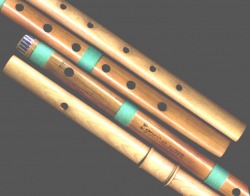Bansuri

A classical instrument since 1940, the bansuri has been the music of folk artists and, as religion and folklore will testify, of cowherds. It has been mentioned in the Vedas and the flute form is known to be one of the most ancient musical instruments.
Structurally, the bansuri is a cylindrical tube, with one sealed end, and uniformly placed nodes. Presently, bansuris have six holes, and the seventh note is played by closing all the holes. Half notes are played by partly closing the holes. A longer length creates medium scale notes while a shorter flute creates higher notes. The Hindustani sangit bansuri is longer and permits two octaves. The bansuri in Carnatic sangit is shorter with eight holes and its musical range spans two-and-a-half octaves.
The seven holes of the older models in Hindustani music permitted each note of the saptak to be played through a separate hole. The notes were be played in ascending order by first closing all the holes, and then opening each in quick succession.
The structure of the bansuri imposes its limitations and complicated ragas such as Mian-ki-Malhar are beyond the scope of the flute. Certain techniques such as murchhana (transposition of notes) solve the difficulty at one point simply by transferring the problem to another point between two other notes. Solutions that may have worked with other instruments do not fit here because the reach of the player's fingers is of paramount importance. Thus, a seventh or an eighth hole may not make possible the three octaves of classical music. Nonetheless, highly creative individuals like Pannalal Ghosh played in three octaves!
Bamboo is the preferred material because it produces a world of overtones that cannot be had in metallic flutes. The sound quality and playing dexterity that is permitted by the bamboo transverse simple instrument.
Breathing and tongue techniques are the key in playing the flute. Altering the breath-force allows for octave changes while tonguing techniques - including pressing the tongue against the back of the teeth - make for a wider playing range. The tatkari technique of cutting notes thus to create staccato sounds is an example of the latter.
The presence of t?s and mukhda from the khayal vocal genre reveals the vocal music origins of the bansuri. Early flautists, including Pannalal Ghosh, played khayal repertoires.
While the bansuri can emulate the human voice and elongate the notes as required by classical music, t?s like chanchar t? cannot be played. Repertoires are necessarily limited.
Pandit Hari Prasad Chaurasia plays in the sitar-sarod style, including features like alap, jod and jhala. His mastery has resulted in a full rendition in terms of swar andlaya, although t?s remains confined to dadra t?, rupak t?, and kaharva t?.
Renowned flautists: Pannalal Ghosh, Devendra Mudeshwar, Pandit Hari Prasad Chaurasia.
